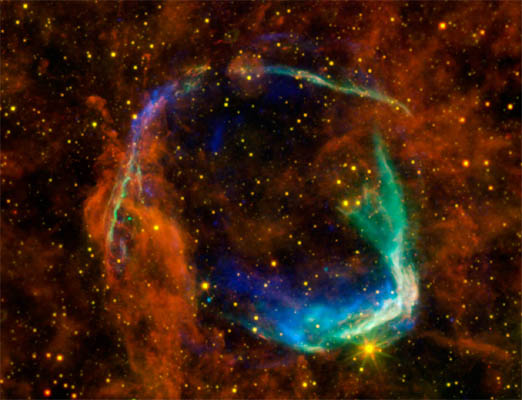Supernova Solved

Note: The following is mostly taken from a really nice article provided by the folks at NASA, so I can’t take credit for the writing here!
In 185 A.D., Chinese astronomers recorded a bright “guest star” in the night sky. By the 1960s, astronomers figured out that the guest star was in fact a supernova, and identified the remains of the stellar explosion. And in 2011, a team of astrophysicists led by NC State researchers solved the mystery of what caused this explosion and why this particular remnant is so very large.
Supernova remnant RCW 86 is much larger than it should be – in fact, if it could be seen in the sky, it would take up more space than our full moon.
“This supernova remnant got really big, really fast,” says Brian J. Williams, postdoctoral research scholar at NC State. “It’s two to three times bigger than we would expect for a supernova that was witnessed exploding nearly 2,000 years ago. Now, we’ve been able to finally pinpoint the cause.”
To do so, astronomers used NASA’s Spitzer Space Telescope and Wide-field Infrared Survey Explorer (WISE) to take infrared readings of RCW 86. That data, as well as previous observational data from NASA’s Chandra X-ray Observatory and the European Space Agency’s XMM-Newton Observatory, showed that the stellar explosion took place in a hollowed-out cavity, which allowed material expelled by the star to travel much faster and farther than it would have otherwise.
The infrared data were also used to confirm what triggered the explosion that brightened the skies in 185 A.D. According to the data, the event is a Type Ia supernova, which means that a star like our sun died relatively peacefully, shrinking into a dense star called a white dwarf. The white dwarf is thought to have later blown up in a supernova after siphoning matter, or fuel, from a nearby star.
“A white dwarf is like a smoking cinder from a burnt out fire,” says Williams. “If you pour gasoline on it, it will explode.”
Supernovae are often thought of as belonging to two main classes: Type Ia and core-collapse. The latter are the most powerful blasts, and are triggered when a massive star runs out of fuel and its core caves in. Unlike core-collapse supernovae, Type Ia always release about the same amount of energy, and, as a result, are used as standard candles to measure distances and the expansion rate of our universe.
Scientists had initially suspected that RCW 86 was the result of a core-collapse supernova, in which a massive star blew up into an empty bubble around it. Such cavities are common in core-collapse events, because massive stars tend to blow material away from them as they age, carving out the cavities. A cavity would also explain why the remains of RCW 86 are so big; when the explosion occurred, the expelled material would have traveled unimpeded by gas and dust, and thus reached great distances quickly.
But the problem was that other evidence pointed against a core-collapse supernova. X-ray data from Chandra and XMM-Newton indicated that the object consisted of high amounts of iron, a telltale sign of a Type Ia blast. Type Ia supernovae involve white dwarfs, and it was not clear, until now, that white dwarfs could also blow bubbles around them before exploding as supernova.
The infrared observations from Spitzer and WISE allowed the team to measure the temperature of the dust making up the RCW 86 remnant (about minus 325 degrees Fahrenheit, or minus 200 degrees Celsius). They then calculated how much gas must be present within the remnant to heat the dust to those temperatures. The results point to a low-density environment for much of the life of the remnant, and show, for the first time, that Type Ia supernova can occur with cavities.
That’s what’s so exciting about the discovery, Williams says. “Type Ia supernovae are seen all the time, and supernovae exploding into cavities are seen all the time, but a Type Ia supernova exploding into a cavity has only been theorized before, and never seen until now.”
Williams’ findings appear in the Astrophysical Journal.
- Categories:


